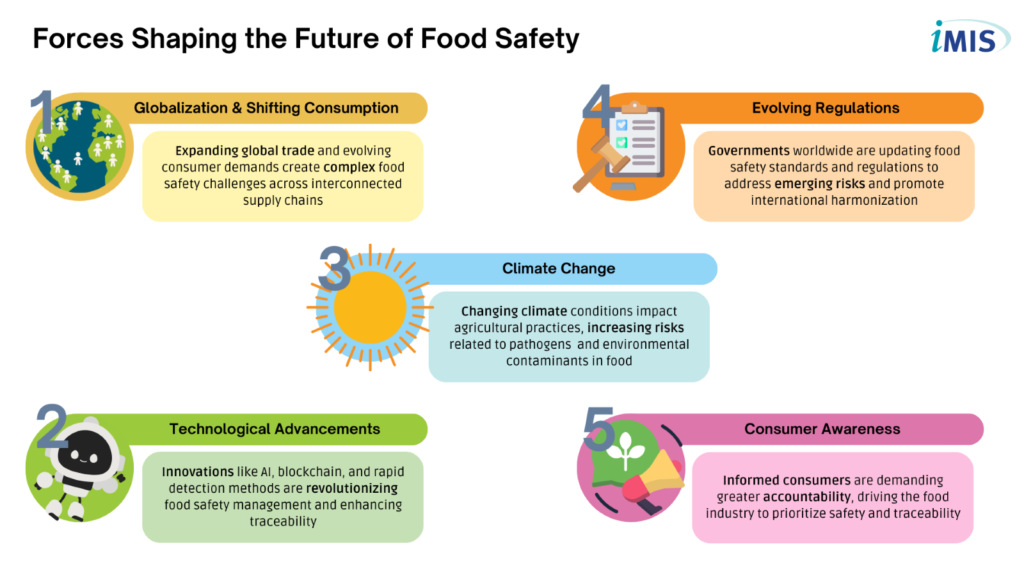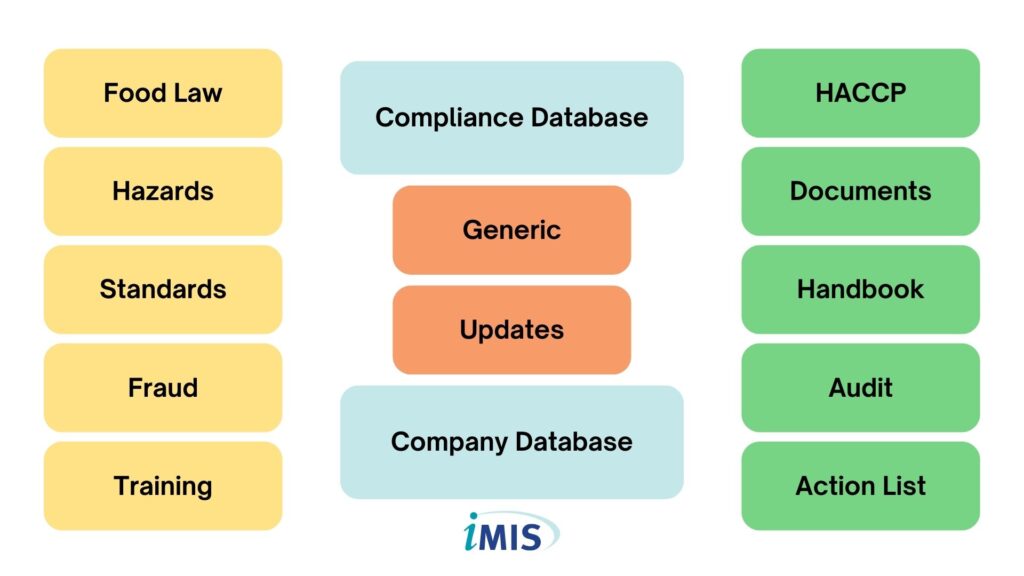Introduction
The food industry is in a constant state of evolution, driven by consumer demands, technological advancements, and regulatory shifts. As we look ahead to 2025, food safety remains a paramount concern. Building on the trends of 2024, the coming year promises even greater emphasis on technology, transparency, and sustainability in ensuring the safety of our food supply.
Key Drivers of Change in Food Safety
The food industry is rapidly evolving, impacting how we produce and consume food (Fig.1) . This transformation, is driven by several key factors that directly influence food safety:
- Globalization and Shifting Consumption: International trade and changing consumer preferences (e.g., for processed foods) create complex supply chains, posing new traceability and control challenges to food safety.
- Technological Advancements: Innovations like AI, blockchain, and rapid detection methods are revolutionizing food safety management.
- Climate Change: A changing climate impacts agricultural practices and the environment. Temperature fluctuations, altered rainfall, and extreme weather can affect pathogen prevalence, mycotoxin presence, and chemical contaminant levels, demanding sustainable practices for long-term food safety.
- Evolving Regulations: Food safety regulations are constantly updated to address new risks and industry changes. International standards, like Codex Alimentarius, help harmonize practices globally.
- Consumer Awareness: Informed consumers demand greater transparency and accountability, driving the adoption of traceability technologies and pushing the industry to prioritize food safety.

The Changing Landscape of Food Safety: Trends to Watch
2025 is poised to be a transformative year for food safety. Driven by technological advancements, evolving regulations, and growing consumer awareness, key trends will reshape how we produce, process, and ensure the safety of our food. Understanding these trends is paramount for everyone in the food industry, from producers to consumers. Let’s delve into the most important food safety trends to watch in 2025.
1. AI and Machine Learning: The Next Level of Predictive Food Safety
Artificial intelligence (AI) and machine learning (ML) are poised to revolutionize food safety in 2025. While we saw initial forays into AI-driven risk assessment and predictive modeling in 2024, the next year will witness even more sophisticated applications.
- Predictive Analytics for Outbreak Prevention: By analyzing diverse data, AI can predict foodborne illness outbreaks with greater accuracy, enabling proactive interventions like targeted inspections and recalls.
- Smart Food Safety Management Systems: Expect to see AI-powered systems that monitor and analyze data from various points in the supply chain, automatically identifying potential hazards and recommending corrective actions in real-time.
2. Blockchain: Enhanced Traceability and Supply Chain Transparency
Blockchain technology, which gained traction in 2024 for its traceability capabilities, will become even more integrated into food safety systems in 2025.
- End-to-End Traceability: From farm to fork, blockchain will enable consumers and regulators to track the journey of food products with unparalleled detail. This granular level of traceability will be crucial for quickly identifying the source of contamination in case of an outbreak.
- Combatting Food Fraud: The immutable nature of blockchain records will help combat food fraud, ensuring the authenticity and origin of products, especially high-value items like seafood and organic produce.
3. The Rise of Cellular Agriculture and Novel Foods: New Safety Considerations
As cellular agriculture (lab-grown meat) and other novel foods gain consumer acceptance and regulatory approvals, 2025 will bring unique food safety challenges.
- Developing New Safety Protocols: Regulatory bodies will be tasked with establishing safety standards and labeling requirements for these novel products. This will involve extensive research into potential allergens, toxins, and long-term health effects.
- Consumer Education and Transparency: Clear communication about the production processes and safety measures related to cellular agriculture will be crucial to build consumer trust and address concerns.
4. Advanced Pathogen Detection Technologies
- Rapid and Portable Detection: In 2025, expect faster, more accessible pathogen detection. Portable, easy-to-use devices will enable on-site testing throughout the supply chain, minimizing delays and enabling quicker responses.
- Whole Genome Sequencing (WGS): WGS, already used in the US, may see increased adoption in Europe for precise pathogen identification and outbreak tracing, enhancing surveillance efforts.
5. Sustainability and Food Safety: An Intertwined Future
The connection between sustainability and food safety will deepen in 2025 (Figure 2). Consumers are increasingly aware of the environmental impact of food production, and this will influence their choices and expectations regarding food safety.
- Reduced Reliance on Chemical Inputs: Expect to see a continued push towards reducing the use of pesticides and antibiotics in agriculture. This shift will be driven by both environmental concerns and the potential for these chemicals to contribute to antimicrobial resistance.
- Climate Change Impacts on Food Safety: Climate change through shifts in temperature, humidity, and extreme weather has an impact on the safety of food. In 2025, expect heightened focus on climate-resilient agriculture and adaptive food safety measures to address these risks.

Figure 2: Global Environment-Friendly and Sustainable Food Market (Data Bridge, 2024)
6. Personalization and the Internet of Food:
- Tailored Food Safety Advice: Consumers may begin to receive personalized food safety recommendations based on their individual dietary needs, health conditions, and even genetic predispositions. Smart kitchen appliances connected to the Internet of Food could play a role in delivering this personalized guidance.
- Data-Driven Consumer Choices: Consumers will have greater access to information about the safety and origin of their food through apps and smart devices, enabling them to make more informed purchasing decisions.
iMIS Food: The Future of Food Safety Management
Building on the trends of AI-powered prediction and blockchain traceability, a new wave of food safety technology is emerging: integrated Management Information Systems (iMIS) for Food. These systems represent a leap forward, offering a unified platform for managing all aspects of food safety.
iMIS Food and the 2025 Trends:
- Data Integration: Like AI and blockchain, iMIS Food thrives on data, aligning with the trend of leveraging big data for improved food safety outcomes.
- Automation: Automating tasks like record-keeping boosts efficiency, mirroring the broader trend of using technology to streamline operations.
- Transparency: Centralized data storage enhances transparency and traceability, meeting consumer demands and supporting blockchain initiatives.
- Proactive Risk Management: Built-in risk assessment tools enable proactive hazard mitigation, reflecting the trend towards preventative food safety measures.
- Streamlined Compliance: iMIS Food helps manage and track compliance, crucial in the face of evolving regulations.

Conclusion
The food safety landscape in 2025 will be shaped by the continued integration of advanced technologies, a growing emphasis on transparency and traceability, and an increasing awareness of the link between sustainability and food safety. While challenges will undoubtedly arise, particularly with the emergence of novel foods and the impacts of climate change, these trends offer promising opportunities to enhance safety and protect public health. By embracing innovation and collaboration, the food industry can build a safer, more resilient, and sustainable food system for all.
Stay Connected: Join our Newsletter!
Ready to learn more? Subscribe to our newsletter for the latest updates, tips, and exclusive content delivered straight to your inbox!
Sources
- bioMérieux. (n.d.). What’s next for foodsafety? Key trends for 2025. Retrieved February 26, 2024, from https://www.biomerieux.com/corp/en/blog/food-safety/What-next-food-safety-Key-trends-2025.html
- Food and Agriculture Organization of the United Nations (FAO). (2023). Safe food for everyone, from farm to table: make it safe. Rome. https://openknowledge.fao.org/server/api/core/bitstreams/e37a57ec-26fe-4c0e-a7e7-4cdc691d5360/content
- Forbes, “How Blockchain Will Transform The Food Industry”, 2023 https://www.forbes.com/sites/forbestechcouncil/2023/06/20/how-blockchain-will-transform-the-food-industry/
- Innova Market Insights. (n.d.). Sustainability Trends. Retrieved February 26, 2024, from https://www.innovamarketinsights.com/trends/sustainability-trends/
- Innova Market Insights. (n.d.). Top Food & Beverage Trends for 2025. Retrieved February 26, 2024, from https://www.innovamarketinsights.com/trends/top-food-trends-2025/
- World Health Organization (WHO). (2023, October 30). Climate change and health. https://www.who.int/news-room/fact-sheets/detail/climate-change-and-health
Related articles to Food Safety Trends to Watch in 2025
Many customers and visitors to this page 'Food Safety Trends to Watch in 2025' also viewed the articles and manuals listed below:
